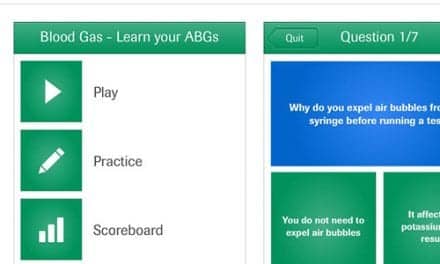Education, training, and competence assessment in a system that promotes ongoing performance feedback to technologists and physicians increase the probability of obtaining valid test results.
 Spirometry is an essential test in the diagnosis and management of pulmonary disease. In addition, airflow obstruction has previously been identified as a marker of increased death from heart disease, lung cancer, and stroke.1-3 The National Asthma Education and Prevention Program (NAEPP) Guidelines for the Diagnosis and Management of Asthma recommend performance of spirometry:
Spirometry is an essential test in the diagnosis and management of pulmonary disease. In addition, airflow obstruction has previously been identified as a marker of increased death from heart disease, lung cancer, and stroke.1-3 The National Asthma Education and Prevention Program (NAEPP) Guidelines for the Diagnosis and Management of Asthma recommend performance of spirometry:
• during the initial assessment;
• after treatment is initiated and symptoms are stabilized;
• at least every 1 to 2 years thereafter; and
• for assessment of airway obstruction reversibility.
The National Lung Health Education Program (NLHEP) also recommends spirometry performance in the prevention and early diagnosis of pulmonary disease. To achieve the goals of each of these programs, reliance on valid test results is essential. A 1991 American Thoracic Society (ATS) document stated, “The largest single source of within subject variability is improper performance of the test.”4 In any quality system, the integration of education, training, orientation, continuing education, and competence assessment is required. The Joint Commission for the Accreditation of Healthcare Organizations (JCAHO) requires evidence of competence assessment.
Defining the Challenge
In a study from New Zealand published earlier this year, Eaton and colleagues examined the quality of spirometry performed in primary care offices and the impact of formal training.5 This is the first study to formally address the quality of spirometry in physicians’ offices. In an analysis of 1,012 spirometry tests from 30 primary care practices, only 3.4% of patients in practices that received no training and 13.5% of patients in practices that received minimal training had three acceptable maneuvers with a reproducible test. The primary reason for failure was lack of a plateau on the volume-time curve. Practical and written assessments were used to quantify the effect of the training workshops. The initial workshop was 2 hours at week 0 with a 90-minute “maintenance of standards workshop” at week 16. The spirometer used in the study also included “built-in” quality assurance features. The practical assessment at week 12 demonstrated a higher portion of the trained individuals (67% vs 16%) performing acceptable tests. The study also demonstrated the need for continuing education to maintain standards. The authors concluded that it is certainly possible that longer, more intensive workshops may produce better results.
In an associated article, John L. Hankinson, PhD, examined the issues related to poor-quality spirometry and the potential for large numbers of false-positive results.6 He concludes that the practicality of a screening program in the primary care setting needs further evaluation.
 Value of Continuous Feedback
Value of Continuous Feedback
The Lung Health Study also demonstrated that technologist performance fell over time.7 In response to this finding, regular monitoring of test session quality and prompt technologist feedback was implemented. The authors demonstrated a dramatic improvement in test results after implementation of the monitoring program. A study performed in 16 primary group practices asked the question, “What makes quality assurance effective?”8 This study assessed the response of the primary group practices with quality assurance associated with eight patient care guidelines. The authors concluded that feedback to providers of data on their performance is a more powerful stimulus for quality improvement than is knowledge of guidelines or discussion of review criteria. The number of corrective actions implemented also contributed significantly to the effectiveness of quality assurance. Both studies suggest that a key element of quality spirometry is continuous feedback.
Banks and colleagues studied the impact of using a spirometer designed to provide immediate feedback on the quantitative and qualitative aspects of each forced expiratory maneuver.9 The authors concluded that a device that strengthens the interaction between the spirometry technologist, the data available to the technologist on the computer, and the participant appears to represent the true underlying lung function more accurately.
A 1997 review article concerning office spirometry in the Journal of Asthma emphasized the proper training of the technologists who perform the testing as perhaps the most important factor in obtaining good spirometric results.10 The authors also suggested that after adequate training, continued competence assessment, periodic in-services, and review of test results are important considerations.
The Training Process
Training, orientation, and educational program components have been outlined and described in previous publications.11,12 The process begins with a well-defined orientation program. Minimally, the ATS standards and American Association for Respiratory Care (AARC) Spirometry Clinical Practice Guidelines (CPGs) are essential reference materials.13,14 Utilization of the procedures for spirometry found in the ATS Pulmonary Laboratory Management and Procedure Manual will prove very useful.15 Incorporate a competence checklist to document adherence to predefined performance standards. The learning objectives for a spirometry-training program may include the following:16
1. Define spirometry abbreviations.
2. Explain the physiology of a forced vital capacity (FVC) maneuver.
3. Perform quality control program components applicable to spirometry.
4. Recognize the clinical indications and contraindications for spirometry performance.
5. Describe the steps for patient preparation, instructions, and performance of spirometry.
6. Explain the criteria for an acceptable test maneuver.
7. Describe the method for the selection of the “best curve” for report generation.
8. List the reference authors used for each parameter and age range.
9. Perform FVC maneuvers on spirometry equipment according to the standard operating procedure.
10. Relate the pattern of the flow-volume curve to specific disease processes.
11. Interpret spirometry data as consistent with obstructive, restrictive, or mixed disease.
12. Understand and apply the AARC CPGs and ATS standards.
13. Understand and apply postbronchodilator testing.
14. Describe common sources of equipment malfunction.
Responding to the Challenge
The AARC has responded to the need for spirometry training and competence assessment through development of a spirometry course based on the ATS standards and the AARC Spirometry CPGs. In addition, the AARC commissioned the National Board for Respiratory Care to develop a spirometry course post-test.
The National Institute for Occupational Safety and Health (NIOSH) course also offers an avenue for training. Both courses are significantly longer and more intense than the workshops described in the New Zealand study.
Conclusion
“At the heart of the whole issue of continuous quality improvement is education. It is education for the technologists who perform spirometry, as well as for physicians and other health care providers. If we pay attention to this, we will indeed truly have an active continuous quality improvement process.”11 Training and competence assessment for spirometry performance is essential to meet the goals of the NLHEP and the NAEPP guidelines. A review of the current studies suggests that a comprehensive program incorporating didactic education, practicums, competence assessment, a spirometer with “built-in” quality assurance features, continuing education, and systematic feedback on performance may yield the highest level of spirometry quality.
 Susan Blonshine, BS, RRT, RPFT, is the director at Technical Education Consultants in Mason, Mich.
Susan Blonshine, BS, RRT, RPFT, is the director at Technical Education Consultants in Mason, Mich.
References
1. Tockman M, Comstock G. Respiratory risk factors and mortality: longitudinal studies in Washington County, Maryland. Am Rev Respir Dis. 1989;140:S56-S63 .
2. Kuller LH, Ockene J, Meilahn E, et al. Relation of forced expiratory volume in 1 second (FEV1) to lung cancer mortality in the multiple risk factor intervention trial (MRFIT). Am J Epidemiol. 1990;132:265-274.
3. Wannamethee SG, Shaper AG, Whincup PH, et al. Smoking cessation and the risk of stroke in middle-aged men. JAMA. 1995;274:155-160.
4. American Thoracic Society. Lung function testing: selection of reference values and interpretative strategies. Am Rev Respir Dis. 1991;144:1202-1218.
5. Eaton T, Withy S, Garrett JE, et al. Spirometry in primary care practice: the importance of quality assurance and the impact of spirometry workshops. Chest. 1999;116:416-423.
6. Hankinson JL. Office spirometry: does poor quality render it impractical? Chest. 1999;116:276-277.
7. Enright PL, Johnson LJ, Connett JE, et al. Spirometry in the Lung Health Study: methods and quality control. Am Rev Respir Dis. 1991;143:1215-1223.
8. Palmer RH, Louis TA, Peterson HF, et al. What makes quality assurance effective? Results from a randomized, controlled trial in 16 primary care group practices. Med Care. 1996;3499:S29-S39.
9. Banks DE, Wang ML, McCabe L, et al. Improvement in lung function measurements using a flow spirometer that emphasizes computer assessment of test quality. J Occup Environ Med. 1996;38:279-283.
10. Wanger J, Irvin C. Office spirometry: equipment selection and training of staff in the private practice setting. J Asthma. 1997;34:93-104.
11. Brown RA, Blonshine SB. Spirometry Quality: The Essentials. Old Town, Me: Health Educator Publications Inc; 1996.
12. Respiratory Care Clinics of North America. Pulmonary Function Testing: Trends and Techniques. Philadelphia:WB Saunders; 1997.
13. American Thoracic Society. Standardization of spirometry—1994 update. Am J Respir Crit Care Med. 1995;152:1107-1136.
14. American Association for Respiratory Care. Clinical practice guidelines: spirometry, 1996 update. Respir Care. 1996;41:629-636.
15. American Thoracic Society. Pulmonary Laboratory Management and Procedure Manual. New York: ATS; 1998.
16. Blonshine SB, Johnson J. Training and Competence Assessment Manual: Pulmonary Diagnostics and Noninvasive Cardiology. Mason, Mich: TechEd; 1999.









